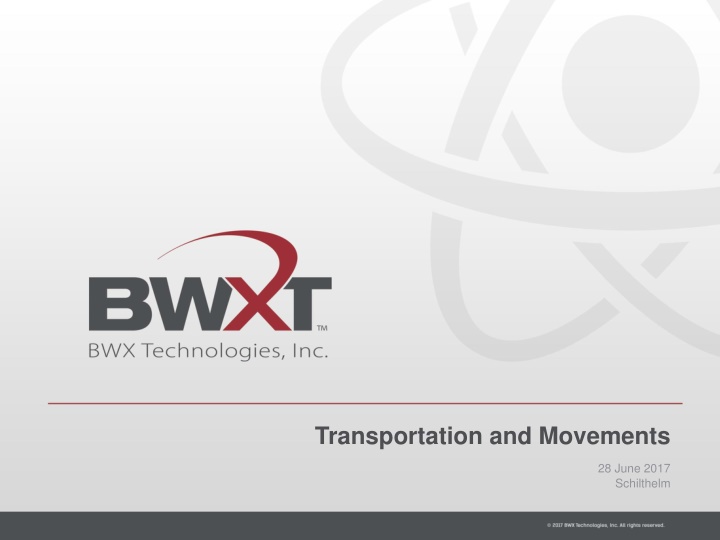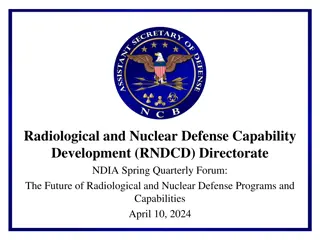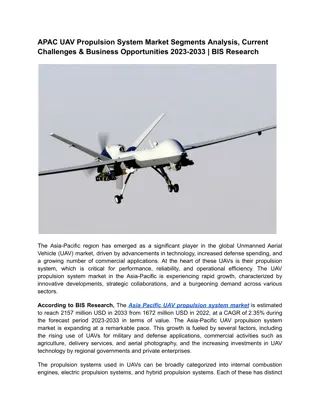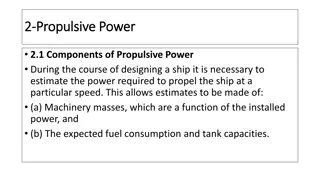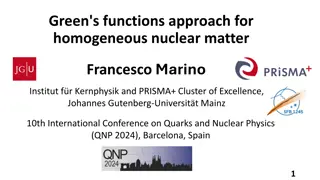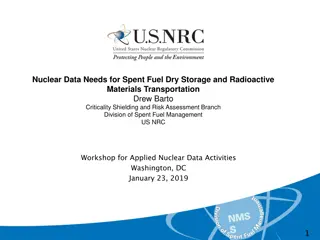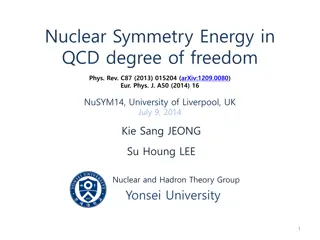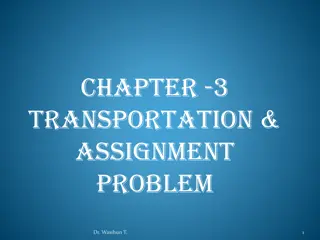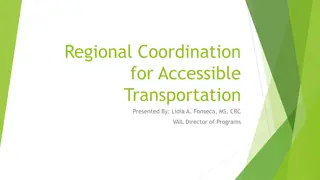Nuclear Propulsion Systems Transportation Overview
This document provides detailed information on the transportation of nuclear propulsion systems, including components from fabricators to testing facilities and assembly transport considerations. It covers various shipment types, container requirements, and post-irradiation transport scenarios. The content emphasizes the need for safety features, shielded containers, and potential new designs for spent fuel shipments. Security evaluations and planning tasks are highlighted for future transportation activities, ensuring compliance with regulatory packaging requirements.
Uploaded on Sep 28, 2024 | 2 Views
Download Presentation

Please find below an Image/Link to download the presentation.
The content on the website is provided AS IS for your information and personal use only. It may not be sold, licensed, or shared on other websites without obtaining consent from the author.If you encounter any issues during the download, it is possible that the publisher has removed the file from their server.
You are allowed to download the files provided on this website for personal or commercial use, subject to the condition that they are used lawfully. All files are the property of their respective owners.
The content on the website is provided AS IS for your information and personal use only. It may not be sold, licensed, or shared on other websites without obtaining consent from the author.
E N D
Presentation Transcript
Transportation and Movements 28 June 2017 Schilthelm .1
NTP Engine and Stages Ground Con Ops (3/23/2017) From NASA Drafted Con-Ops .2
Nuclear Thermal Propulsion Engine Development Con Ops (3/23/2017) From NASA Drafted Con-Ops .3
Transportation Test Articles Transportation Description Requirements/Considerations Fresh fuel from DOE to Fuel Fabricator (BWXT) Type A Fissile Shipment This is a typical transportation activity for which there will likely be existing containers Fuel Components/Critical Experiment components from fabricator (BWXT) to facility licensed to testing facilities (Boxes 6-8 on TR Plan) Type A Fissile Shipment There are likely shipping containers available for small articles or assemblies Reactor assembly or components from fabricator (BWXT) to Stennis Type A Fissile Shipment Can consider either subcomponents or full nuclear subsystem with poison to maintain subcritical Post irradiation transport of nuclear subsystem (NSS) from Stennis to onsite inspection facility Requires a shielded container with safety features but does not have to be qualified for offsite transportation Post irradiation transport of NSS from Stennis to offsite inspection facility Type B Fissile Shipment (Spent Fuel) May need a new container design depending on attributes of material Waste disposal spent fuel Type B Fissile Shipment (Spent Fuel) May need a new container design depending on attributes of material The types and packaging requirements are defined in 10 CFR 71 .4
Transportation Flight Article Transportation Description Requirements/Considerations Fresh fuel from DOE to Fuel Fabricator (BWXT) Type A Fissile Shipment This is a typical transportation activity for which there will likely be existing containers. Reactor assembly or NSS components from fabricator (BWXT) to Stennis Type A Fissile Shipment Can consider either subcomponents or full NSS with poison to maintain subcritical Post assembly and checkout transport from Stennis to KSC Type A Fissile Shipment (Type B if irradiated) Likely requires a new container design BWXT currently evaluating as part of planning task. Security requirements also being reviewed .5
Transportation Flight Article Transportation Description Requirements/Considerations Post Irradiation transport of NSS from Stennis to onsite inspection facility Requires a shielded container with safety features but does not have to be qualified for offsite transportation Critical experiment components from fabricator (BWXT) to facility licensed to execute zero power physics experiments This needs discussion and definition. This is different than initial startup testing of A3 nuclear subsystem Type A Fissile shipment. Reactor assembly or NSS components from fabricator to Stennis Can consider either NSS components or full reactor assembly with poison to maintain subcritical. Type A Fissile Shipment. Post Irradiation transport of NSS from Stennis to onsite inspection facility Requires a shielded container with safety features but does not have to be qualified for offsite transportation BWXT currently evaluating transportation requirements and existing capabilities .6
